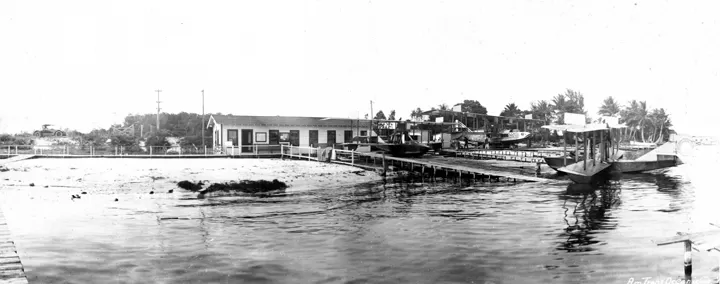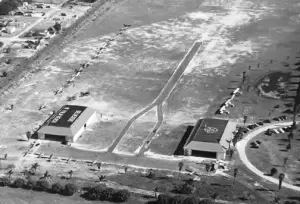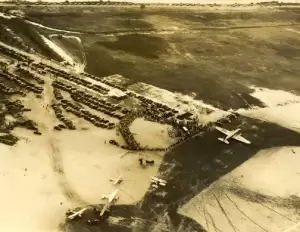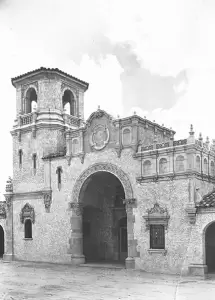Getting Around: Planes and Trains

By 1918 seaplanes were landing at water bases on Lake Worth, because no land-based airports existed in Palm Beach County. There were seaplane bases in Palm Beach, West Palm Beach, Lake Worth, and Lantana. During World War I, Roosevelt Seaplane Base was in use in front of now-Rosarian Academy on Flagler Drive, West Palm Beach. After the war, American Trans Oceanic Company ran an international airport at this base and offered flying lessons, passenger flights, and sightseeing tours.
C. Dimick Reese, Jr., great-grandson of Elisha N. Dimick, recalled the Palm Beach base, located just south of the Royal Park Bridge, from his childhood in an oral history interview in 2006:
[W]here Lake Drive is now, the seawall and the lake were right there, just a few feet away. … I would say there were probably three or four planes there. [They parked the planes] practically up in Lake Drive [with] wooden ramps coming up over the seawall, and they’d run those planes up the ramps. … [S]ince it was right there next to the bridge, … [e]ven if they were going to take off in a northerly direction, they’d have to go south to give themselves running room. I believe that operation was gone by the time I came back after World War II. Matter of fact, they moved the seawall. … That may've been when the seaplane base closed, when they put the seawall way out further, creating the park that’s there now.
C. Dimick Reese, Jr.
In 1927 Murray Carmichael turned 200 acres of his property into Belvedere Field, located along Belvedere Road between Belvedere Country Club and the Palm Beach Kennel Club. The small airport, popular for sports aircraft, was gone by 1955.

Grace K. Morrison came to Palm Beach from Atlanta and was the first woman pilot to solo in Palm Beach County. She learned to fly in 1932 and as president of the Palm Beach County Airport Association, led the drive to build a public airport. Morrison was killed in an auto accident near Titusville three months before it opened in 1936; it was named Morrison Field in her honor. Architect Maurice Fatio, Morrison’s employer from 1926 until her death, donated 200 trees to the 440-acre site.

On December 19, 1936, the day Morrison Field was dedicated, a 14-passenger Pan American/Eastern Airlines DC-2 made the first commercial flight from the facility, which cost $180,000. Eight passengers and three crew members were on board, including celebrated pilot Dick Merrill, who was forced into a crash landing in Pennsylvania by bad weather. No one was seriously injured.

In 1925 the Seaboard Air Line Railway became the second train line to service West Palm Beach. To keep up with the influx of people to south Florida, Seaboard added an extension from Coleman, in Sumter County, through central Florida, just north of Lake Okeechobee to West Palm Beach on its way to Miami and Homestead. George Greenberg, a boy at the time, recalled the first day it came through in an oral history interview in 2006: “The president of the railroad was standing at the rear of the [last train] car, and everybody in town was out there to greet him.” Seaboard prospered during Florida’s rapid development, but in 1930 entered bankruptcy. A court-appointed receiver controlled it until 1946, when it was reorganized as the Seaboard Air Line Railroad. Today Tri-Rail and Amtrak use the Seaboard station as a passenger terminal; the CSX Railroad owns the Seaboard track.

